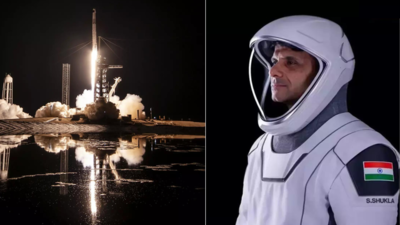The International Space Station (ISS) has officially welcomed its first Indian astronaut, Shubhanshu Shukla, amidst a flurry of excitement.

Shubhanshu Shukla's inaugural video from space showcases the Indian flag, evoking a sense of national pride and accomplishment.
The Dragon series' fifth spacecraft, Grace, successfully docked with the ISS over the North Atlantic Ocean on Thursday at 16.01 IST.
Shukla is the second Indian to journey into space, following Rakesh Sharma's historic flight in 1984. He is joined on the Axiom-4 mission by Slawosz Uznanski-Wisniewski, marking Poland's return to space after a long hiatus, and Tibor Kapu, Hungary's first astronaut in 45 years. The crew launched from Nasa's Kennedy Space Center on Wednesday.
Gaganyaan, India's ambitious indigenous human spaceflight program, is slated for launch by 2027. This mission aims to position India among the elite nations, including Russia, the United States, and China, that have independently accomplished manned space missions.
Shukla's experiments aboard the Axiom-4 mission directly contribute to the Gaganyaan program. His research explores the effects of microgravity on vital aspects of long-term human spaceflight, including plant growth, muscle loss, mental health, and microbial behavior. He is also studying tardigrades to understand survival in extreme environments. The goals are to develop sustainable space food systems, ensure astronaut well-being, and enhance life support strategies for future Indian space missions.
Nasa and Isro are preparing to launch the $1.5 billion NISAR satellite in July from India's Satish Dhawan Space Centre. This advanced Earth-observing mission will employ high-precision radar to monitor surface changes continuously, providing critical data for farming, climate studies, and natural disaster management.
Unlike many Earth-observing satellites that are restricted by daylight and clear weather, the Nasa-Isro NISAR mission overcomes these limitations with advanced radar technology, enabling 24/7, all-weather imaging. This will facilitate more precise and consistent monitoring of natural disasters, environmental changes, and agricultural trends.
The NISAR satellite is expected to revolutionize the fields of science, agriculture, and disaster response on a global scale.
Newer articles
 The 'Good Cop, Bad Cop' Parenting Strategy: Does It Do More Harm Than Good?
The 'Good Cop, Bad Cop' Parenting Strategy: Does It Do More Harm Than Good?
 5 Natural Ways to Strengthen Your Heart and Reduce Disease Risk
5 Natural Ways to Strengthen Your Heart and Reduce Disease Risk
 Broadside: Broad Slams India's Team Choices After Headingley Test, Calls for Edgbaston XI Changes
Broadside: Broad Slams India's Team Choices After Headingley Test, Calls for Edgbaston XI Changes
 Wimbledon Serves Up India: Tennis Giant Courts Cricket-Crazy Nation for Growth
Wimbledon Serves Up India: Tennis Giant Courts Cricket-Crazy Nation for Growth
 England's Ben Duckett: The New Virender Sehwag? Former Coach Draws Bold Comparison
England's Ben Duckett: The New Virender Sehwag? Former Coach Draws Bold Comparison
 Archer Set for England Return? Broad and Buttler Advocate for Pacer's Second Test Inclusion
Archer Set for England Return? Broad and Buttler Advocate for Pacer's Second Test Inclusion
 Ashada Gupt Navratri 2025: Unveiling Dates, Timings, and Esoteric Significance
Ashada Gupt Navratri 2025: Unveiling Dates, Timings, and Esoteric Significance
 Suryakumar Yadav's Sports Hernia Surgery: What It Is, Who's at Risk, and Path to Recovery
Suryakumar Yadav's Sports Hernia Surgery: What It Is, Who's at Risk, and Path to Recovery
 The Evil Eye: Protective Charm or Portal to Darkness? Exploring the Symbol's Dual Interpretations
The Evil Eye: Protective Charm or Portal to Darkness? Exploring the Symbol's Dual Interpretations
 Jaiswal Eyes Gavaskar's 49-Year Record: India's Opener Nears Milestone 2,000 Test Runs in Edgbaston Clash
Jaiswal Eyes Gavaskar's 49-Year Record: India's Opener Nears Milestone 2,000 Test Runs in Edgbaston Clash